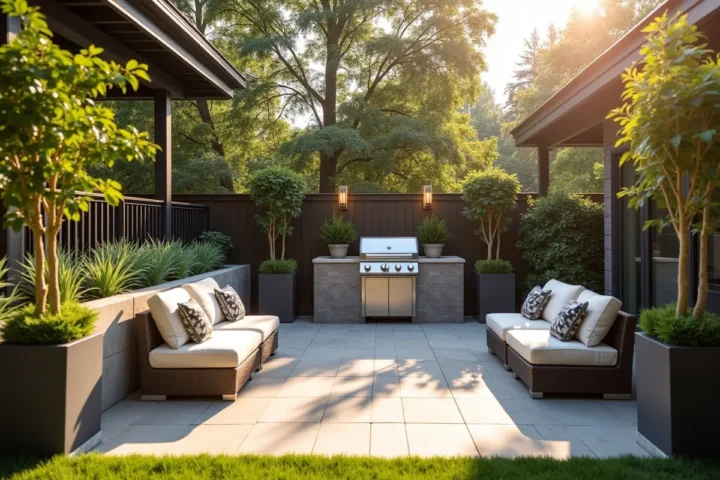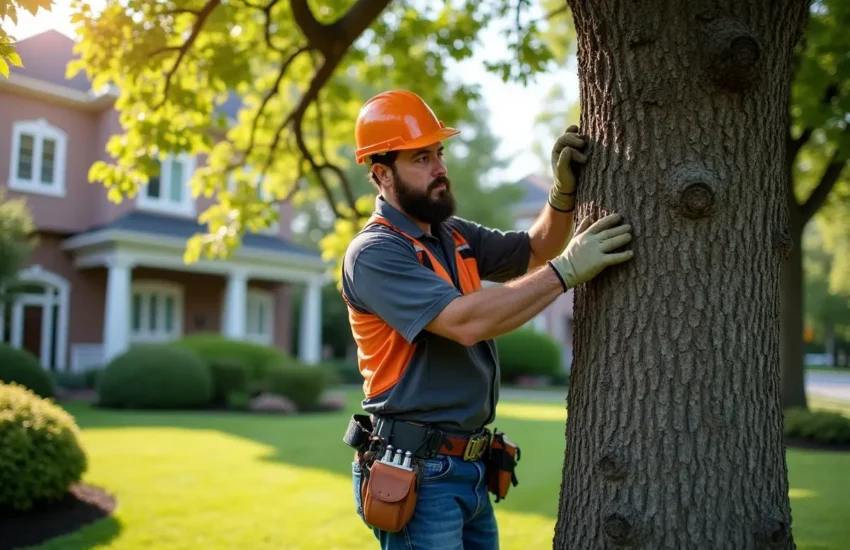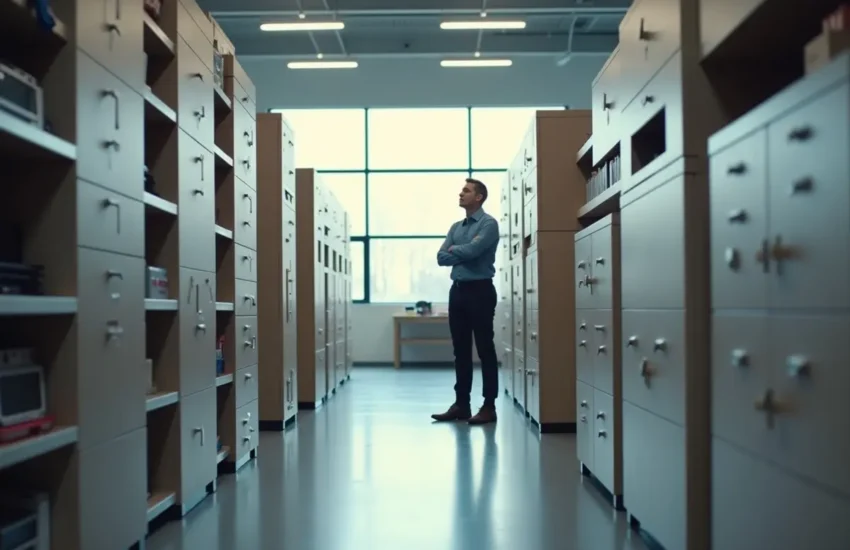Enhancing Outdoor Living Spaces with Functional Design Elements
Are you ready for the secret to building an outdoor space that actually gets used?
It’s no secret that every homeowner fantasizes about having that dream backyard retreat. A place to relax after a long day at work, grill on the weekends, and finally enjoy being outside.

But here’s the thing…
Outdoor spaces quickly become wasted square footage if you don’t design them properly. In fact, only 18% of homeowners use their outdoor living spaces as much as they want to.
It doesn’t have to be that way.
In this guide, I’m going to share all the functional design elements that turn any backyard into an oasis you’ll actually use. Let’s get started!
Table of contents:
- The Outdoor Living Boom
- Foundation Elements to Prioritize
- Choosing the Right Materials
- Designing Multi-Functional Zones
- Design Features That Increase Curb Appeal
The Outdoor Living Boom
Outdoor living is more than just a trend these days.
Outdoor living is now one of the primary investment strategies for American homeowners. The outdoor living structure market is estimated to grow to $3.66 billion by 2033 and for good reason.
Homeowners are finally coming to one simple but important realization…
Your backyard is just as valuable as any other room in your house. 98% of experts agree that having an updated outdoor living space has a significant impact on home value.
Here’s another stat: Nearly 63% of homeowners say they would prioritize outdoor living spaces if they were to remodel.
This tells you everything you need to know about where educated homeowners are spending their remodeling budgets.
Foundation Elements to Prioritize
Let’s start with the basics.
Every great outdoor space begins with a solid foundation. This is where most DIY’ers get tripped up: they overlook the fundamentals and focus on the aesthetics instead.
The Importance of Base Materials
It’s all about what you build on.
The most durable outdoor living space foundations are modern materials like fibre-reinforced concrete rather than traditional brick or wood. Reinforced concrete such as fibre is more crack-resistant and will create a much more stable surface that lasts decades. It can handle heavy furniture loads and extreme temperatures far better.
Why does this matter?
Because building your outdoor living space on a high-quality foundation will ensure your investment lasts for generations rather than years. You want materials that will stand up to foot traffic, heat/cold, heavy furniture loads, BBQ grills, and even pool equipment.
The right base material can save you money over the long-term by reducing maintenance needs and avoiding expensive repairs.
Size Does Matter
Here’s something most people get wrong with their outdoor living spaces…
They’re either too small or too big. The average patio in the U.S. is around 290 square feet.
This doesn’t mean it’s the right size for you.
Consider how you will actually use the space. Will you be entertaining 12 guests at a time, or is it a more private area for morning coffee? Align the square footage with your lifestyle, not just what you see in magazines.
Choosing the Right Materials
What’s the biggest difference between a DIY outdoor project and a professional one?
The material choices. The types of materials you use will determine how much maintenance you have to do, how long your space lasts, and how it looks in the long-term.
It’s Not Just About Looks
Remember how we said the right foundation was crucial for longevity?
The same is true for the surfaces you choose for patios, decks, etc. You don’t have to sacrifice style for durability anymore. Modern outdoor materials provide both.
Concrete options like poured concrete allow for clean modern surfaces, while stamped concrete can imitate natural stone surfaces. Flagstone is a natural material with timeless appeal, while travertine and granite offer more elegant patterns and ultimate strength and durability.
The trick is mixing materials that complement each other while serving different functions.
Winning Materials Are Low Maintenance
Here’s the truth…
Nobody wants to be spending their weekends maintaining their outdoor oasis. This completely defeats the point of having a relaxing space.
Choose materials that are as maintenance-free as possible: composite decking that resists weathering, sealed concrete or stone surfaces that don’t stain or fade, powder-coated metal fixtures and furniture that won’t rust, and UV-protected fabrics.
Pick the lowest maintenance options that still fit your style. You want to spend more time using your outdoor space and less time cleaning it.
Designing Multi-Functional Zones
Ready to get a little more creative?
The best outdoor spaces aren’t just big empty areas. They’re divided into functional zones for different activities.
The Social Hub
This is where the party’s at.
Every outdoor living space needs a dedicated gathering area: this is where you spend the most time entertaining, eating meals, and hanging out with guests. Your social hub should include plenty of seating, a central focal point (a dining table, fire pit), good ambient lighting for nighttime use, and convenient access to indoor facilities like restrooms and kitchens.
Plan for traffic flow. Guests should be able to move around without having to squeeze past furniture or creating traffic jams.
Quiet Nooks
Not everything is about socializing.
Designate an area that is a little more private and tranquil. This is the space for you to read a book in peace, listen to music alone, or just sit quietly and enjoy being outside. This could be a hammock between two trees, a cozy seating nook with cushions, or even a barebones meditation area.
The key is to make this zone feel separate from the main social area. Use plants, screens, or even changes in level to visually divide this space.
Practical Areas
The entertainment and relaxation areas are important, but don’t forget the “behind the scenes” stuff.
Outdoor cooking and food preparation areas are a must-have for many households. Storage for cushions, equipment, etc. Trash/recycling access, and hose/bib and electrical outlet locations are all details that must be considered.
Work these practical elements into your design from the beginning rather than trying to tack them on later. This will always look like an afterthought.
Design Features That Increase Curb Appeal
Now let’s add some wow-factor elements.
These are the outdoor design features that take your space from “nice” to “spectacular.”
Clever Lighting
The right lighting makes all the difference.
It allows you to use your outdoor space for more hours of the day, sets the mood, and increases safety. The most effective outdoor lighting plans use a layered approach of:
- overhead string lights for general ambient illumination,
- path lights for safety and visibility,
- accent lights to highlight specific features, and
- task lights for areas where you need focused light (kitchen counters, BBQ area, etc. ).
Pro-tip: Install dimmers wherever possible. The ability to change the intensity of lighting completely changes the ambiance of your space.
Weather Protection
Outdoor spaces are amazing, but they do become useless in the rain.
Retractable awnings, fixed roof structures, pergolas with adjustable louvers, and shade sails for a more modern look are all great options.
The right coverage system means you can enjoy your outdoor space rain or shine. It allows for year-round use of your backyard.
Built-In Elements
Built-in features make spaces look more intentional and put together.
Outdoor kitchens with permanent fixtures, built-in seating walls with hidden storage, planters incorporated into hardscaping, and fire features for focal points are all examples of built-in elements.
These permanent additions increase property value while also improving usability.
Wrapping It Up
Outdoor living spaces are not about following the latest trend.
It’s all about functional design elements that actually improve your backyard usage. From selecting the right foundation materials to creating distinct zones for different activities, every decision you make needs to have a clear purpose.
The homeowners who truly transform their outdoor spaces are the ones who end up using them more. They’re not stuck with beautiful but impractical layouts that look great but don’t function very well.
Begin with a quality foundation, choose durable materials, and design with your lifestyle in mind. The end result? A backyard oasis that becomes an extension of your home — one you’ll enjoy for years to come.


